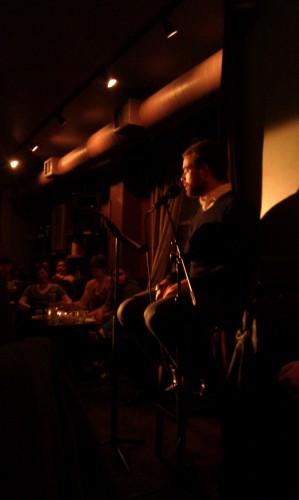2nd Story

Reading at 2nd Story. Photo by Sharon A. Mooney.
2nd Story events feature a hybrid of storytelling and theater. They usually take place at Webster’s Wine Bar in Lincoln Park, where performers read a first-person story with a conversational tone, enhanced by some sound design. I read at 2nd Story a couple weeks ago and had a damn good time.
Bobby Biedrzycki, a 2nd Story company member and adjunct professor in Columbia College Chicago’s Fiction Writing Department saw me read at a Creative Nonfiction Week event in fall 2010 and asked me to submit a story and audition. I sent them my story “The Impersonator” in March of 2011, and so began a long and rewarding process which culminated in me doing two readings at Webster’s.
Early that summer, I was called to audition at the 2nd Story office in an old industrial building on Ravenswood Ave. I sat in a semicircle and read my piece to Bobby and three other people. I felt comfortable, because it was a lot like the semicircles that we sit in in Story Workshop classes at Columbia. And the coached reading that we do at Columbia probably helped my audition, which would explain why so many Columbia folks are involved with 2nd Story.
A few weeks later, they emailed me and asked me to read in a show in March of 2012 called “Mixed Roots,” with a focus on identity and heritage. I played the waiting game for about six months then started meeting with the other performers for my show in January. It went in two stages.
First, me and the three other performers had a writing workshop with the show’s curator, C.P Chang. We read our stories to one another and gave each other feedback on big picture story structure stuff, along with the ways that we could transform our work into something that could be performed, as well as read on the page.
Me and Lizzy were the two people with writing backgrounds in the group. Lizzy’s story was about being the only Polish kid on her block in an Irish neighborhood in deep Southside. The other two performers, Jasmin and Jaz, came from theater backgrounds and were writing about living in Little Village and about growing up as a white kid with a black stepfather. Our stories complimented each other well, and it was interesting to see what the theater people brought to the table as opposed to what the writers did.
After three workshops, I had a strong idea of what I was going to do with my story, and C.P. had me start working one-on-one with the show’s director, Jessica Kadish. When I met with Jessica, I sat on a stool like I would be at Webster’s and read her sections of my piece. Then we’d go over things like gestures and inflection — what needed to be emphasized to make my point and tell my story. Since prolonged description doesn’t do well when being read out loud, a lot of that had to be done with tone of voice, facial expression or a simple gesture while reading. It was new for me, and it felt weird — to be cutting what felt like necessary stuff from my story in the name of performance. I think of a story as something that survives alone on the page. 2nd Story changed my idea of that. For 2nd Story, I was writing a story that might seem thin on the page but that I enhanced as its specific reader/performer.
The day before the show, I met with Jessica and the sound designer, Nick Kawahara, and we picked places where music would be played under my reading. I was glad to use some favorites by the Dungeon Family and Mount Kimbie, but wish we had found a way to work in “Choppin’ Blades” by UGK. Maybe next time…
Things went well. We had a sold out crowd the first night at Webster’s, and I was up first. I sat in the stool. They cut the house music and introduced me. “Watch for the Hook” came on for a couple bars, and I started talking. I won’t lie — I was a little concerned that the folks at a fancy wine bar wouldn’t be my best audience. I’m not a wine bar guy. I prefer to drink whiskey at home in my underwear. And the last time I had a cheese plate was when I microwaved some pizza. But it was fun. People laughed when I hoped they would, and my story seemed to inspire others to share their stories with me throughout the course of the night.
The main thing I wanted to change for the second night was that I wanted to read faster. At Columbia, we’re always coached to “slow down and see it” when we read, and I think I was doing that a bit too much, sacrificing the energy of my story. I remedied that on the second night by downing a cup of coffee a couple of hours before heading to Webster’s. That night, as I sat in the stool, vibrating with caffeine, I felt ready to kill it. At times, doing 2nd Story felt like a drawn-out process, but by the time I was performing, I understood why I had to put so much work into it.
WEEK LINKS
2nd Story made a podcast out of my caffeinated reading from the second night. Stream it on their site, or click the link there to download it for free from iTunes.
